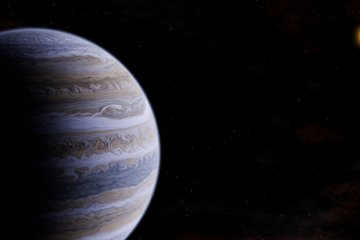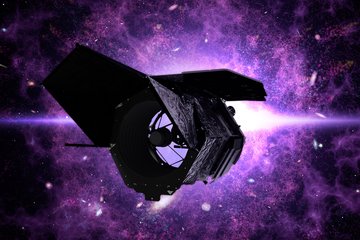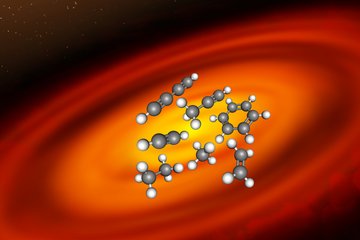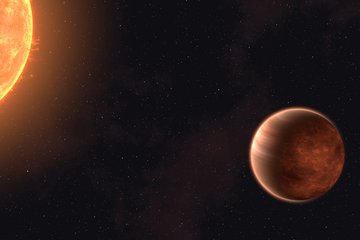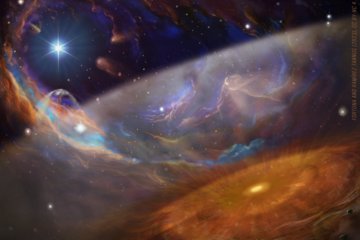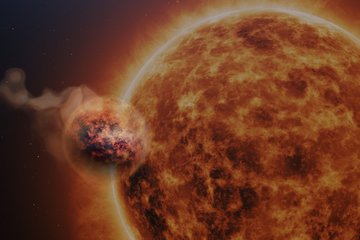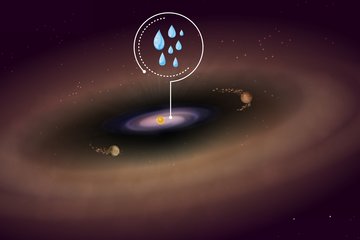Planet Hunting
Exoplanets - planets around star other than the sun - are nowadays being found by the dozens and start to be characterized in detail now.
Projects
The most important of the projects with our participation are listed here.
In-Transit Detection

Thousands of extrasolar planets in the immediate Solar neighborhood remain unexplored, many of them are expected to be roughly Earth-sized and in temperate, potentially habitable orbits. The ExoEarth Discovery and Exploration Network(EDEN) transit survey is a large-scale search for habitable Earth-sized planets around nearby low-mass stars. These M-type stars represent the largest population of stars in the universe but impose great observational challenges due to their intrinsic faintness. In contrast to most ongoing and past surveys, the EDEN team utilizes large research telescopes (0.8m–2.4m), which allows for efficient probing of the habitable zones even of the faintest of these stars.
The full-scale survey was launched in 2018 and is currently using a total of 8 telescopes at 6 sites around the globe. EDEN is an international collaboration with teams on three continents and is led by Prof. Daniel Apai at the University of Arizona. As a major contractor, MPIA contributes more than 100 nights with the Calar Alto 1.2m telescope to help accomplish the ambitious goal of finding closeby habitable planets. These observations are conducted by a local team of currently 11 PhD students, enabling them to gain hands-on experience with a professional research telescope.

To date, the vast majority of thoroughly characterized exoplanetary systems (i.e., those for which we have precise masses and radii, most of which transit their stars) are part of the so-called "hot Jupiter" family --- exoplanets in short-period orbits (and thus, large equilibrium temperatures) whose detection and characterization is relatively easy to perform with current technology. In contrast, only a handful of transiting giant exoplanets in longer-period orbits (> 10 days and, thus, "warmer" in terms of their equilibrium temperatures) have been discovered and thoroughly characterized, as their longer periods makes them hard to detect with ground-based observatories. These so-called "warm" giant exoplanets, are in turn key to our understanding of the formation and evolution of giant exoplanets, including the giant planets in our own Solar System. It is in this context that the *W*arm G*I*a*N*ts with T*E*SS (WINE) collaboration was formed --- a multi-institutional effort involving researchers from the Max-Planck Institut fuer Astronomy (MPIA) in Germany, the Pontificia Universidad Católica de Chile (PUC) and Universidad Adolfo Ibañez (UAI) in Chile and the Space Telescope Science Institute (STScI) in the United States --- which is aimed at the detection and characterization of these warm giant exoplanets using data from the Transiting Exoplanet Survey Satellite (TESS) mission. The main goal of the project is to perform a systematic study of warm giant exoplanets starting with their detection and photometric and spectroscopic follow-up using ground-based facilities, to the understanding of how these systems form and what they are made of. The project is currently led by Dr. Rafael Brahm (PUC), Dr. Néstor Espinoza (STScI), Prof. Dr. Thomas Henning (MPIA) and Prof. Dr. Andrés Jordán (UAI).

HAT-South is a collaboration among the Max Planck Institute for Astronomy, the Princeton University, the Australian National University, and the Pontificia Universidad Catolica de Chile. It consists of a network of six identical, fully automated wide field telescopes, located at three sites in the Southern hemisphere. Each of the three sites operates two TH4 instruments, for increased sky coverage and redundancy in case of failure. Every TH4 instrument has a mosaic field of view of 8°×8°, so each site monitors 128 square degrees of sky. The primary purpose of the project is to detect and characterize a large number of extrasolar planets transiting nearby bright stars. The three sites permit near round-the-clock monitoring of selected fields, and the continuous data-stream greatly enhances recovery of planetary transits.
Radial Velocity

CARMENES is a twin high-resolution spectrograph at the 3.5m telescope on Calar Alto. It was built by a consortium of five German and six Spanish institutes and designed to carry out a precision radial velocity (RV) survey of 300 nearby M dwarfs in search for orbiting exoplanets. This survey was started in January 2016 and will use a total of 750 guaranteed nights. The instrument has both a visual and a near-infrared channel covering 520 - 960 nm and 960 - 1710 nm, respectively, at a resolving power of R ~ 90,000. A dual fibre-link from the Cassegrain focus of the 3.5m telescope feeds both spectrographs. The visual channel of CARMENES has a demonstrated RV measurement precision of ~ 1 m/s, well comparable with that of other state-of-the art instruments designed for this purpose. Due to its wavelength coverage that extends relatively far into the red part of the spectrum (up to 960 nm) the CARMENES visual channel is particularly suitable to identify false positives in the form of spurious RV signals that are not caused by orbiting planets, but iinstead by stellar activity, i.e. rotationally modulated star spots. The reason for this is that the amplitude of star spots signals is strongly wavelength dependent, and that this effect, dubbed "chromaticity", is most pronounced around 800 nm. In order to be able to claim an exoplanet discovery it is important to understand and account for these activity-related signals. The precision of the near-infrared channel is not quite as high than that of the visual one due to the lower RV information content (in terms of spectral lines) at the wavelengths it covers. Nevertheless, moderately strong RV signals can also be observed in the near-infrared channel, which suitably extends the applicable range for studies of the chromaticity. During the first five years of the survey, CARMENES has discovered more than 30 planets and confirmed 17 further planets initially discovered in other surveys.

The occurrence rate and period distribution of (giant) planets around young stars is still less well-constrained than that of older main-sequence stars. This is mostly owing to the intrinsic activity-related jitter and the avoidance of young stars in most large planet search programs. Yet, dynamical re-structuring processes in young planetary systems may last significantly longer than the actual planet formation phase and may well extend into the debris disc phase. The RVSPY survey for planets around young stars is designed to search for sub-stellar companions in the planetary and brown dwarf mass regime around >100 young stars that are surrounded by debris discs. Many of these stars are also observed by the NaCo-ISPY direct imaging survey, such that the synergy of the two surveys will provide unique insides on the occurrence of giant planets over a wide range of orbital periods. In a first project phase, between 2018 and 2021, short-cadence observations with 14-20 RV measurements for each star, spread over 2-3 weeks, are obtained with the FEROS spectrograph at the 2.2m MPG/ESO telescope on La Silla/Chile to search for hot Jupiters and characterise the stellar activity jitter. In a second phase, the stars with small enough activity jitter will be monitored for a few more years to also search for longer-period planets.






